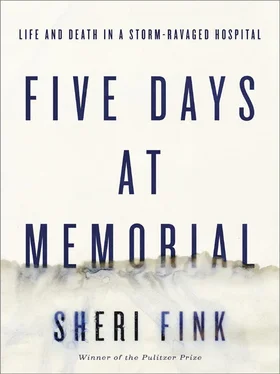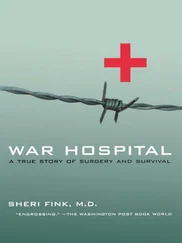I told her that we spoke with our FEMA contact and that he said we are on the list. She said that is good and that Fema is getting all the other hospitals out in the area as well, but not them. SO, if we are on the list that means that FEMA has a plan to get to us.
It was unclear whether Robichaux or her interlocutor at Memorial realized that FEMA itself does not operate rescue helicopters. “If we run into trouble [Memorial] will help coordinate with us to get our patients out.”
Robichaux returned to typing out employees’ messages to loved ones on the pharmacy computer. At about five thirty p.m. the connection failed. The power had gone down in part of the hospital. She rushed to the bedsides of two patients on ventilators on the west side of the building, where power had been expected to go out first. The plan was to move them to the north side of the floor, which was supplied by a different generator.
The lights came back on after just a few minutes, but the team moved the two patients anyway.
“We lost all power on the West side for a few minutes,” LifeCare’s pharmacist texted.
“I’m glad you are back,” someone on the outside replied. “Scared us for a little while.”
The gravity of the situation was becoming clearer. Even the elevator had stopped working, perhaps taken offline to avoid the possibility of someone getting stuck. Two of LifeCare’s patients still needed to go downstairs for dialysis.
“We are now pushing for MMC to take at least some of the most critical patients if possible,” Robichaux wrote.
Dubois wrote back that she and her colleagues would arrange transport from wherever the helicopters dropped the LifeCare patients, using ambulances or Angel Flight, a company that provides free air medical transport. The important thing was to get the ventilator- and dialysis-dependent patients out quickly.
On that front, Robichaux had disappointing news. “MMC is wanting a list of ambulatory patients first.” Patients who could walk. It was another shift from the original idea of maintaining a singular focus on getting the most vulnerable and dependent out first. By this point the patient Anna Pou had tried to resuscitate had died. Only seven of LifeCare’s surviving fifty-two patients made the list. Perhaps they could be transported by boat. “I know it is not our critical but at least it will get some out for now.”
The news grew grimmer. Memorial’s CEO warned that an additional fifteen feet of water was expected around the hospital. A rumor had started that the Army Corps of Engineers was considering blowing up a levee, causing even deeper flooding in the city. And the LifeCare employees in Shreveport had spoken with a tearful Knox Andress. They texted to say they had learned from him that the situation in other hospitals might be even worse. “It is a total mess. Hospitals are out of oxygen. People being bagged for eighteen hours, patients in the water.”
At close to sunset, an orange-and-white Coast Guard Jayhawk helicopter descended onto Memorial’s helipad, landing beside a smaller private aircraft. The roar of the rotors and the odor of fuel carried into LifeCare. Any employee could look out the windows of the nursing station on the west side of LifeCare and watch the evacuations. Patients who remained on the west side could see the helicopters from their beds. A huddle of hospital volunteers, including family members of patients and staff who had been organized into transport teams, lifted a patient into the Jayhawk, then jogged away from its whirring rotor blades, heads bent.
Still, LifeCare patients had not moved. What Memorial offered was this: the corporate overseers at Tenet would be asked for permission to transport LifeCare patients with the Coast Guard. “I hope and pray this is not a long process for getting their approval,” Robichaux wrote to her colleagues. Why Tenet corporate permission should be required for LifeCare to use federal rescue assets was unclear. From Memorial’s fourth-floor command center, community relations manager Sandra Cordray typed a message to Michael Arvin at Tenet about LifeCare. Her message did not sound a note of urgency.
We are priotorizing our patients—can you work directly with LifeCare corp? Thanks.
If Memorial could get LifeCare’s fifty-two patients to a staging area just outside New Orleans, she told him, LifeCare could meet them with ambulances and take them to Baton Rouge.
At around seven thirty p.m., Cordray followed up with Arvin, sending him contact information for LifeCare’s Robbye Dubois. There would be no more National Guard trucks that day, she added. The water had risen too high. The second set of patients had left for Nacogdoches around six thirty. “Let me know what is worked out for Lifecare patients regarding how will leave. Thanks.”
More than an hour came and went. LifeCare’s Robbye Dubois wrote Cordray from Shreveport to say she was awaiting approval to get ambulances en route, a process she expected to take hours. Arvin had not called her. She requested his phone number and finally spoke with him after nine p.m. “Been on the phone with Tenet,” she reported back to Robichaux. “Will eventually be to our patients. May be in the morning because the water has risen to the point they cannot get trucks to you. I will have ambulances to the staging area. Critical will go first. They will contact me when first patient leaves LifeCare.”
Robichaux confirmed that if the backup power went down and they lost the computer connection, they would proceed with the plan, sending patients to the staging area in the morning, critical ones first with staff to care for them. They expected the patients would start moving between three and eight a.m.
Nobody wrote it directly in a message, but some employees began to worry that the choice of which patients went out first could affect their medical outcomes. A realization dawned on Memorial’s incident commander, Susan Mulderick, that day. The variability in the sizes of helicopters that were landing and the length of time it was taking to move patients to the helipad left her with one conclusion: not all of the patients would be getting out alive.
IT HAD BEEN a grueling few hours for the Memorial command team. During the brief power outage that also affected LifeCare, they had temporarily abandoned the command center and regrouped in an area of the first floor used by security guards. Then most of the radios that they’d been using to communicate across the hospital’s vast campus had stopped working. So, too, did one of the few ventilation systems left functioning, in the unit for vulnerable bone marrow transplant patients. It was now blowing hot air.
The command staff and Arvin in Texas had worked for hours and found a receiving hospital for those patients, in vain it seemed. At around nine p.m., a call from the Coast Guard to the incident command staff left the impression that the governor had instructed helicopter pilots to take patients to any hospital that would accept them. “We no longer have any control over destinations,” Cordray wrote to Arvin.
What the command staff didn’t seem to have considered, perhaps hadn’t even been aware of, was the relatively small number of medical transport helicopters flying in the region and the large number of hospitals in New Orleans that now needed to be evacuated. Flying a patient or two to a Tenet hospital out of state would take a helicopter out of commission for hours, even as it might provide the best possible care for those patients. Some pilots wanted to make only quick trips to a highway interchange. The cloverleaf at Interstate 10 and Causeway Boulevard served as a staging area just west of the city. The idea that patients would be dropped off on “lily pads” on their way to more definitive care had been part of the Hurricane Pam exercise. The lily pads were known as SARBOOs—search-and-rescue bases of operations. However, a system to supply the sites and transport patients from them remained to be planned.
Читать дальше













